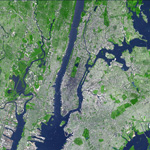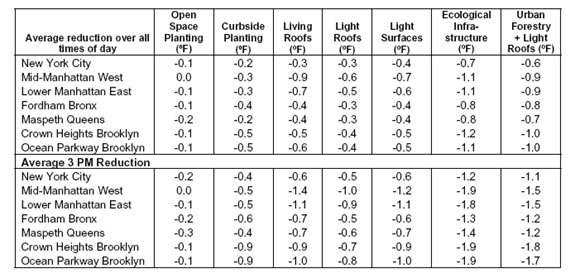Case Study - NYC UHI Mitigation
In NYC, increases in vegetation reduce UHI

New York City is home to nearly 8.2 million people distributed over a land area of only 305 square miles (Wikimedia, 2011) making it the most densely populated city in the United States. In 2004 the New York State Energy Research and Development Authority (NYSERDA) in collaboration with Columbia University, Hunter College, and New York Energy $mart program funded a project to improve scientific understanding of the urban heat island. The objectives of the project were to perform climate and meteorology modeling, estimate the impact of urban heat island mitigation on energy demand and provide information about UHI mitigation to policy makers based on study results (NYSERDA, 2006).
New York City, like other metropolitan areas, is experiencing an increase in temperature due to urban heat island effect. UHI has had regional impacts on energy demand, air quality and public health (USEPA, 2011b). Currently there are several mitigation strategies to help reduce the effects of UHI. However, before implementing mitigation, NYSERDA wanted to test and evaluate which strategy would be the most effective. The mitigation strategies NYSERDA evaluated were urban forestry, green roofs and light colored surfaces.
The study divided the regional area into six specific case studies, and evaluated nine mitigation scenarios. Below Table 1 illustrates the breakdown of each mitigation scenario:
 Table 1. (NYSERDA, 2006)
Table 1. (NYSERDA, 2006)
Each scenario were evaluated on four criteria including cost-effectiveness at reducing air temperature and consequent lower demand for electrical energy for air conditioning (Wikimedia, 2011). The objectives of the study are to:
- Analyze and model the heat island effect in New York City;
- Test urban forestry, living roofs, and light surfaces as potential heat island mitigation strategies city-wide and in six case study areas;
- Improve scientific understanding of how urban heat island mitigation strategies affect New York City’s surface and near-surface air temperatures;
- Evaluate potential interactive consequences associated with heat island mitigation strategies with particular attention to land use, electric loads, and potential air quality and/or health impacts;
- Test the impact of temperature reduction on energy demand; and
- Determine the cost-effectiveness of each strategy.
Conclusions of the NYC Case Study:
The study revealed that vegetation had a most significant effect on reducing the average air temperature than albedo or other built features (building heights or road density) (Konopacki, et al., 1998). Below, Table 2 compares the six “case study” locations and their air temperature reductions for each mitigation strategy.
 Table 2. (NYSERDA, 2006)
Table 2. (NYSERDA, 2006)
From this study, NYSERDA concluded that the redevelopment of urban surfaces to increase vegetation cover would be the most effective mitigation strategy for the city of New York.
(By Kiersten Lee/Gregory Möller)

